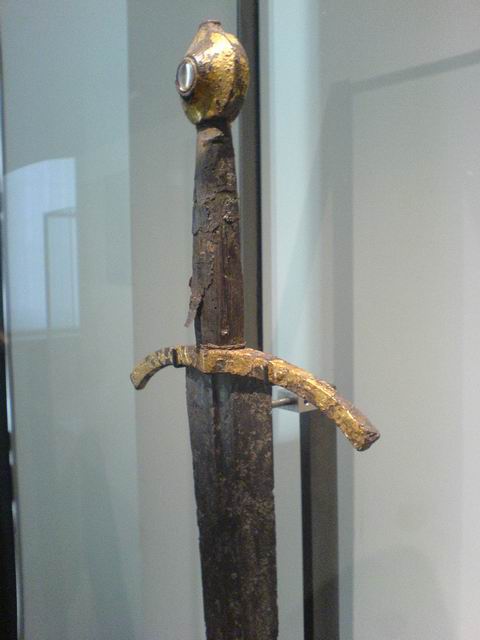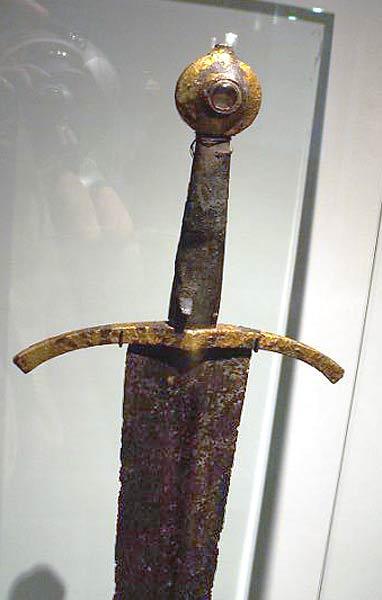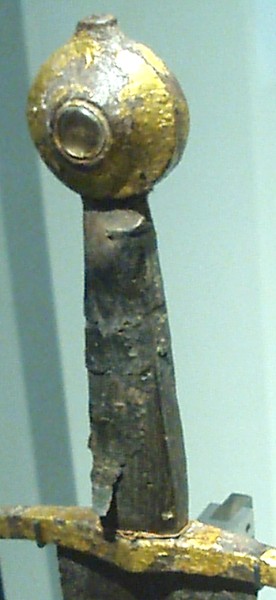
Please have a look at this image and describe the grip section(s). I'm not sure I'm seeing it correctly.
 Attachment: 27.55 KB
Attachment: 27.55 KB


Appears roughly hexagonal to me, although the outer edges may be a bit rounded over, maybe through use?
Thanks, Victor. Does anybody see anything different? Does this next image add anything?
 Attachment: 26.22 KB
Attachment: 26.22 KB


I think the hex may be a play of the light. It looks like a normally shaped grip to me, though I lack the vocabulary to name the shape in one word.
M.
M.
Sean,
If we look at the ferule at the bottom of the grip (as oriented in the pictures, and as Oakeshott preferred to describe swords), I looks to me like the grip has a definite central ridge, but I would hesitate to call it hexagonal. There is charing, aging, or just plain darker grain on the near side of the grip in the first photo that makes it look like there is a ridge, but I do not think that is in fact the case. Instead, it looks like a typical tapered oval or a tapered oval that has had a couple of flats filed onto the front and back faces to form a central ridge. (Yes, I know that wouldn't really be an oval, but like M. Eversberg II, I do not know how else to describe the shape). Either way, the narrow sides of the grip appear to me to be curved, not angular, based on the shape of the upper portion of the grip and the ferule at the bottom.
Hopefully that helps at least a little.
-Grey
P.S. It's a pretty sword, even with the gilding (I'm not a huge fan of yellow metals). Do you have any info on the sword (where it is, date, province of find, etc.) that you are willing to share?
If we look at the ferule at the bottom of the grip (as oriented in the pictures, and as Oakeshott preferred to describe swords), I looks to me like the grip has a definite central ridge, but I would hesitate to call it hexagonal. There is charing, aging, or just plain darker grain on the near side of the grip in the first photo that makes it look like there is a ridge, but I do not think that is in fact the case. Instead, it looks like a typical tapered oval or a tapered oval that has had a couple of flats filed onto the front and back faces to form a central ridge. (Yes, I know that wouldn't really be an oval, but like M. Eversberg II, I do not know how else to describe the shape). Either way, the narrow sides of the grip appear to me to be curved, not angular, based on the shape of the upper portion of the grip and the ferule at the bottom.
Hopefully that helps at least a little.
-Grey
P.S. It's a pretty sword, even with the gilding (I'm not a huge fan of yellow metals). Do you have any info on the sword (where it is, date, province of find, etc.) that you are willing to share?
Hard to tell, but perhaps this is a shallow oval with the sides in line with the edges flattened. I don't know if this was a common shape in the middle ages, but it was a very common grip section in the 1700s.
--ElJay
--ElJay
Definitely looks like a flatten oval to me too.
Not so sure if an octagonal grip would benefit the sword esthetically.
Cheers,
J
Edit: Greyson, I haven't checked, but I'm almost positive this is the Type XIV kept in the musee de L'armee in Paris.
Not so sure if an octagonal grip would benefit the sword esthetically.
Cheers,
J
Edit: Greyson, I haven't checked, but I'm almost positive this is the Type XIV kept in the musee de L'armee in Paris.
Is that leather covering the wood? it looks very odd to me. And the recess of the pommel... very neat.
Here is another picture I've taken myself. I don't think the ridge is real, I guess it's merely the shadow of the piece of leather playing tricks with our eyes... To me the grip seems essentially rectangular with filed corners towards the cross.
The sword is in Paris, in the Musée de l'Armée. Here is a translation of the associated notice:
(see the original french here)
I'll possibly go to the museum this week-end, I can bring back more pictures of the sword if you like and check the cross section with my own eyes :)
Regards,
 Attachment: 42.2 KB
Attachment: 42.2 KB

The grip.
The sword is in Paris, in the Musée de l'Armée. Here is a translation of the associated notice:
| Quote: |
| Sword.
French work?, circa 1350 This sword, traditionally associated without any real proof to a royal origin, was supposedly discovered in the XIXth century in a grave near Toulouse. It is mounted according to the traditional cruciform scheme. Its wide and powerful blade, with strong edges mainly suitable to cuts, is lightened by a central fuller within wich a chivalric inscription is written, on both sides in gilded brass letters: NULLA DE VIRTUTIBUS TUIS MAJOR CLEMENTIA EST (None of your virtues is greater than mercifullness) At the center of the circular pommel lies an opening holding the rock cristal capsule that is meant to keep the relicas(?) in place. The grip of wood was originally protected by a metal wire wrap; pommel and cross are covered by a gilded silver sheet. Inv. J PO 678 |
I'll possibly go to the museum this week-end, I can bring back more pictures of the sword if you like and check the cross section with my own eyes :)
Regards,

The grip.
I think your photo settles the question for me, Vincent. I thought this looked like a soft rectangular section but I wanted to be sure before I finished my grip. I'll have to work out the details by feel. It's an interesting option. The grip of the Sancho IV sword also is of rectangular section. It's worth noting that both swords are high-status weapons with richly decorated hilts/grips. I don't know if that has any bearing on the shape of the grip.
Yes, that's thin leather clinging to the grip core, which answers other questions about the thickness of the cover and whether or not the core was bound with cord. The museum description provided by Vincent complicates things. Wire binding. Hmmmmm. I wonder if a plainer version of this sword would have only the leather-over-wood construction. I'm not interested in a high-status weapon.
The details of this Musee d L'Armee sword are above so I won't repeat them here. I'll simply add that this weapon is discussed in ROTMS (no photo, though--only a sketch).
Thanks, everybody! You've helped me step away from the oval grip section and create something more uncommon. :D
Yes, that's thin leather clinging to the grip core, which answers other questions about the thickness of the cover and whether or not the core was bound with cord. The museum description provided by Vincent complicates things. Wire binding. Hmmmmm. I wonder if a plainer version of this sword would have only the leather-over-wood construction. I'm not interested in a high-status weapon.
The details of this Musee d L'Armee sword are above so I won't repeat them here. I'll simply add that this weapon is discussed in ROTMS (no photo, though--only a sketch).
Thanks, everybody! You've helped me step away from the oval grip section and create something more uncommon. :D
Sean,
The section is rectangular, with swelling sides and slightly rounded edges. A cross between oval and rectangular. Elegant, practical and efficient.
I saw this sword when I last visited Paris, and made a point of noting some details.
The section is rectangular, with swelling sides and slightly rounded edges. A cross between oval and rectangular. Elegant, practical and efficient.
I saw this sword when I last visited Paris, and made a point of noting some details.
| Peter Johnsson wrote: |
| Sean,
The section is rectangular, with swelling sides and slightly rounded edges. A cross between oval and rectangular. Elegant, practical and efficient. I saw this sword when I last visited Paris, and made a point of noting some details. |
Thanks for that confirmation, Peter. I've done the rough work on the grip. Now I can proceed to the final shaping!
Vincent,
Thank you for that picture; it makes the whole grip look very different.
Peter,
Thank you for corroborating the information from Vincent's photo.
-Greyson
Thank you for that picture; it makes the whole grip look very different.
Peter,
Thank you for corroborating the information from Vincent's photo.
-Greyson
Page 1 of 1
You cannot post new topics in this forumYou cannot reply to topics in this forum
You cannot edit your posts in this forum
You cannot delete your posts in this forum
You cannot vote in polls in this forum
You cannot attach files in this forum
You can download files in this forum
All contents © Copyright 2003-2006 myArmoury.com — All rights reserved
Discussion forums powered by phpBB © The phpBB Group
Switch to the Full-featured Version of the forum
Discussion forums powered by phpBB © The phpBB Group
Switch to the Full-featured Version of the forum